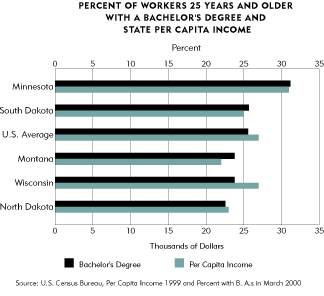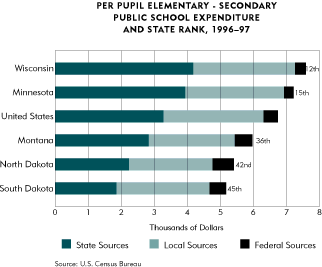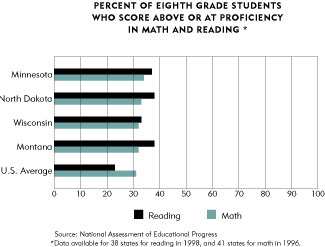More education means more pay
Economists generally agree that a highly educated workforce is consistent with a growing economy and higher income levels. The more education a worker has attained, the more productive he or she will be on the job. Highly educated workers tend to earn more pay since employers offer higher wages to attract and retain them. On average, a worker with a college degree receives a wage premium of about 50 percent above the wages of those with a high school diploma, while a worker with a graduate degree receives a premium of over 100 percent.

It should not be surprising, therefore, that a highly educated workforce is also consistent with higher state per capita income levels. States with a higher percent of workers with at least a bachelor's degree tend to have higher levels of per capita income. (See map.)
District states generally follow the national trend—as levels of college education attainment increase, so does per capita income. On the high end, Minnesota ranks seventh in the nation for the percent of the population with at least a bachelor's degree and 11th in per capita income. On the low end, North Dakota ranks 40th in college education attainment and 38th in per capita income. The exceptions are Wisconsin and Montana, which have almost the same percent of population with a bachelor's degree. However, Wisconsin has a much higher level of per capita income, while Montana has a much lower level of per capita income, ranking almost last in the nation. (See "Putting a Finger on the Grand (Income) Canyon," for analysis of Montana's per capita income in the December 2000 Region magazine.)
State sources provide the most funds for education
Wisconsin and Minnesota rank the highest in the district for total education expenditure per pupil, primarily due to a relatively large amount of money allocated by their state governments. Nationally, on average 49 percent of education spending comes from state sources, 45 percent from local and 6 percent from federal. Wisconsin and Minnesota rank seventh and eighth in the nation for the per pupil amount of state funding for education, while Montana, North Dakota and South Dakota rank below 35th. However, these three states combined receive 10 percent of their education funds from the federal government; for Wisconsin and Minnesota, only 4 percent of spending comes from federal sources. Federal funding is higher in Montana and the Dakotas.

District students score high in math and reading
If you are looking for some help with addition or multiplication, ask a district eighth-grade student. According to results of assessment tests administered by the National Assessment of Educational Progress that measure performance in reading and mathematics, district states rank in the top three positions in math: Minnesota, first; North Dakota, second; and Montana and Wisconsin tie for third (South Dakota did not participate in the NAEP state assessments). In reading, Montana and North Dakota rank fourth, Minnesota is sixth and Wisconsin, 12th.
This is good news for district states relative to the nation. Nevertheless, the results also suggest plenty of room for improvement. For example, while Minnesota scored the highest in the nation for the percent of eighth-grade students who scored above or at proficiency in math, 66 percent of Minnesota students finished below proficient levels. The NAEP describes proficient as solid academic performance and competency over challenging subject matter.
Although not many of us are in the market for a "gen-u-ine" Tyrannosaurus Rex fossil, the business of casting and selling replicas, as well as selling smaller fossils, is a growing trade in North and South Dakota and Montana, where dinosaur remains are plentiful. Both real fossils and replicas from these states have been sold around the globe, and regional tourism gets a boost from professional and amateur diggers, museumgoers and other enthusiasts.
What lies beneath the economic boom of the fossil industry is controversy regarding where they can be collected and by whom and whether a profit should be made from their discovery. Much of the dispute stems from the fact that the business of collecting fossils in the name of science is viewed completely differently from collecting them on a purely commercial basis. Commercial collecting strikes a nerve with some paleontologists, and the two groups are at odds regarding the true value and ownership of a fossil.






